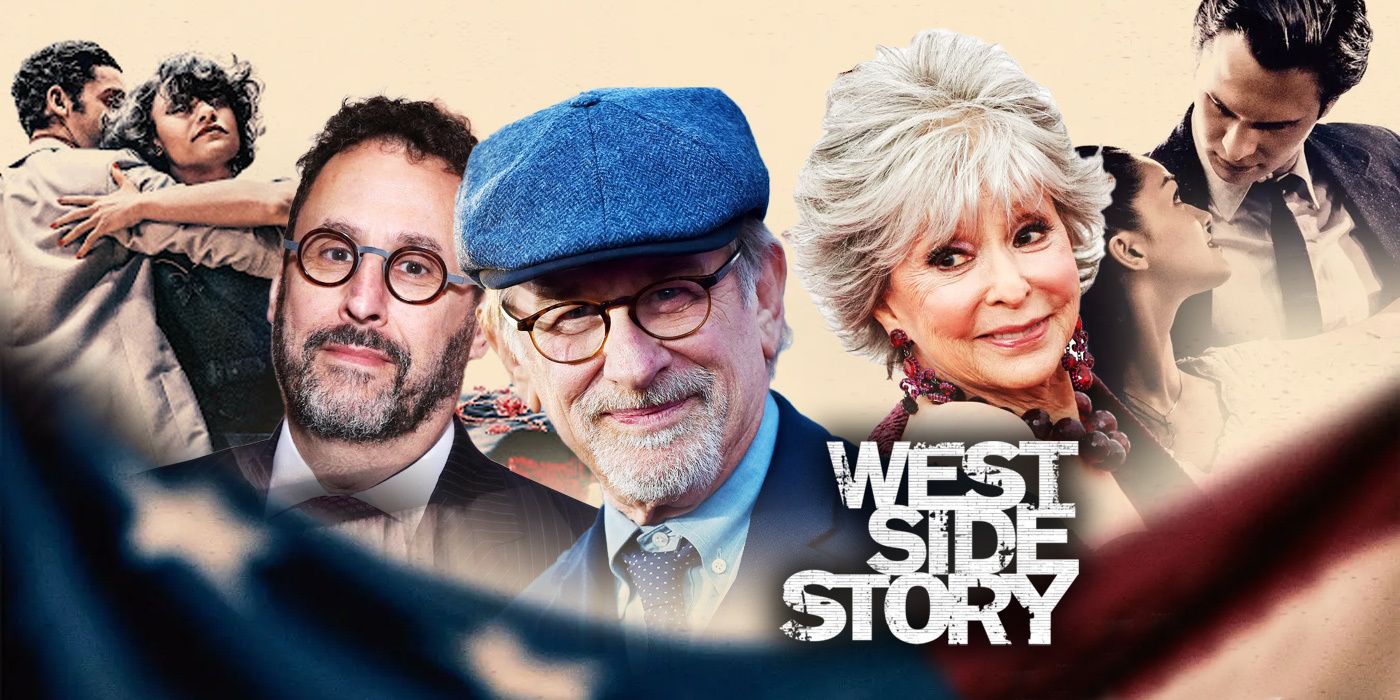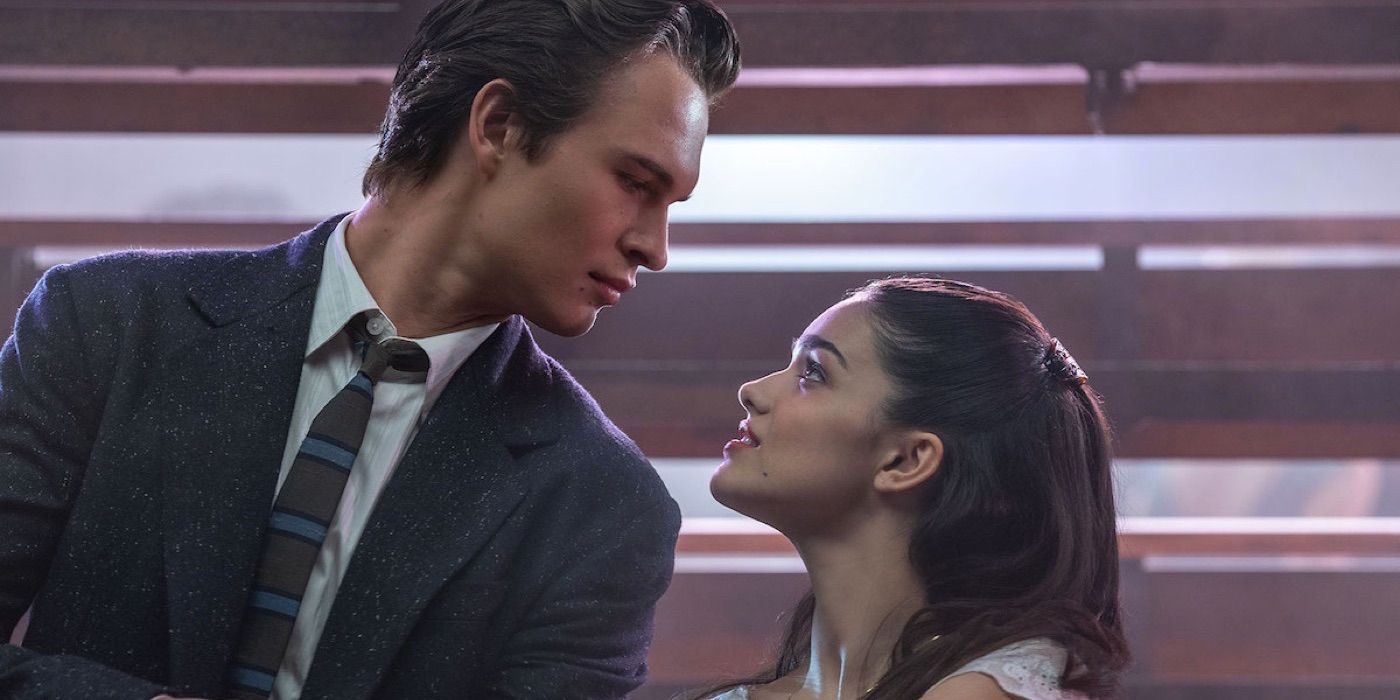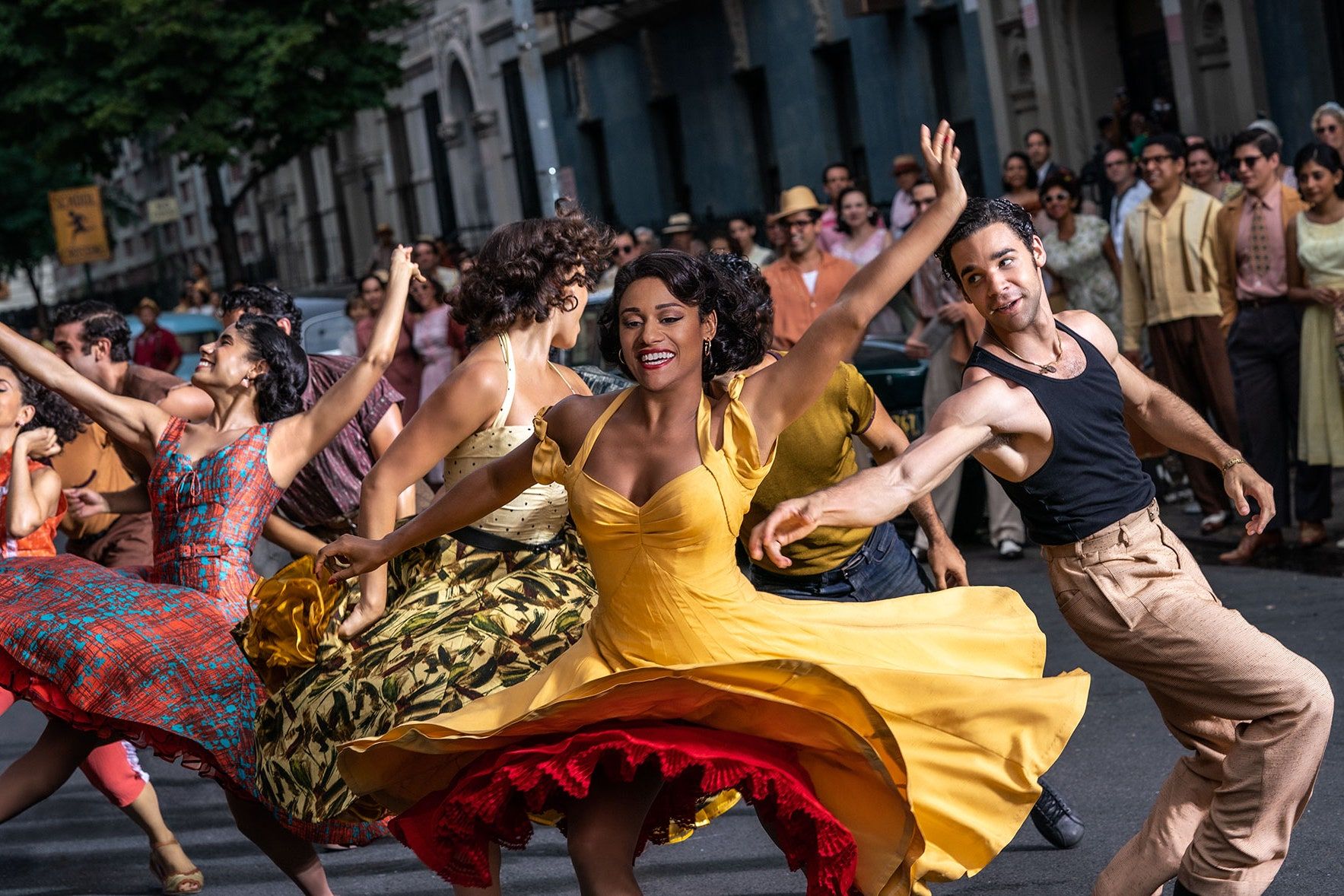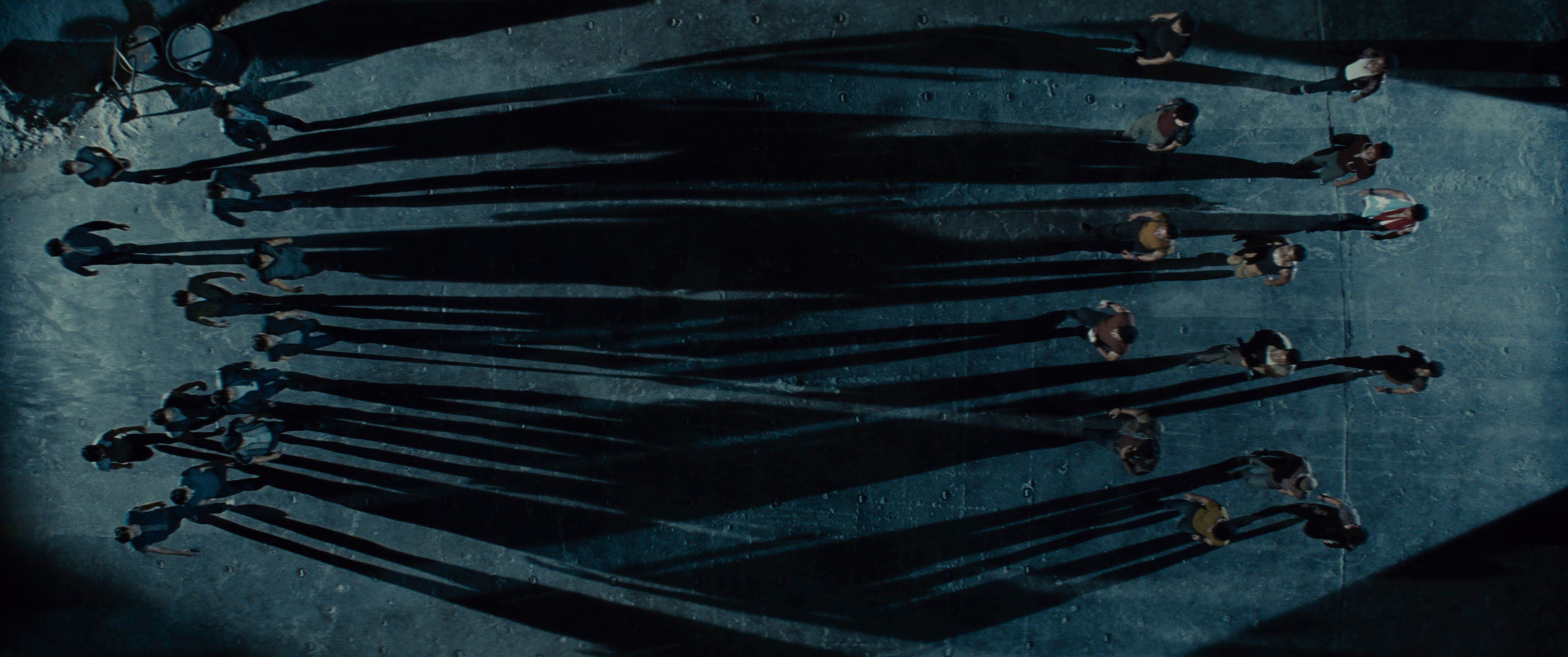From Academy Award winning director Steven Spielberg and Pulitzer Prize and Tony Award winning screenwriter Tony Kushner, this vibrant retelling of the musical West Side Story tells the tale of rivalry between the Jets and the Sharks, with the young love of Tony (Ansel Elgort) and María (Rachel Zegler) in 1957 New York City at its center. With their forbidden romance on the verge of discovery and tension between the street gangs at an all-time high, family, loyalty and love will be questioned, as a divided city threatens to erupt.
During a press conference for the film, Spielberg and Kushner were joined by EGOT (Emmy-Grammy-Oscar-Tony) winner Rita Moreno (who played Anita in the original film, and is now an executive producer while also playing Valentina) to talk about what a great time they had making their adaptation of West Side Story, the rehearsal experience, passing the torch, how involved lyricist Stephen Sondheim was with the production, recreating and capturing the New York City of a different era, the use of Spanish throughout the film, the challenge of the extreme heat, whether they ever considered setting the film in present day, and what they felt the most pressure to get right.
Question: Steven, you’ve said the last time you had as great of a time making a movie was with E.T.
STEVEN SPIELBERG: I did.
You’ve also said that, as a kid, you knew all the lyrics of West Side Story. During some of the scenes, did you want to jump up out of your chair start singing and dancing with the cast?
SPIELBERG: I did jump out of my chair, and I did sing and dance with the cast, singing off key, and dancing like I had three left feet, during rehearsal. We did four and a half months of intensive rehearsals, both in the city at Lincoln Center and in Brooklyn in a place called Dumbo. That’s when I was really able to jump out of my chair. Rita was there too, and Rita was dancing with the cast. We were so compelled to get up on our feet because there was so much life in the air, with the song and dance and this genius choreographer, Justin Peck, getting a muscular dance style with all the male and female dancers. But when I made the movie, no. I was a director and I didn’t even tap my foot. I was just too focused on the monitor and on what we were getting and what images we were capturing. But this was the most delightful family affair I’ve had since E.T. I felt like I was a dad to all of those kids. I was never a dad in my real life, but E.T. made me wanna be a dad, so my first child was born three years after I directed E.T. And this was the next time I had that kind of a feeling, that I was part of a very diverse family and I was not in the center of the family, but I was simply a part of the family.
TONY KUSHNER: One of my favorite moments in the whole process of making it didn’t involve Steven dancing. Really early on, we were in some rehearsal room somewhere, and Justin had just began to choreograph some little part of “America,” just experimentally, to see what it like. Steven and I were supposed to just sit and watch, and Steven got so excited that he took out his iPhone, sat on a dolly, and was pushed around because he just couldn’t stand sitting there. He had to get into the middle, which is what was so exciting about this in the first place. He’s such a great director. It was a great director working with a great choreographer and dances. It was all experimental, but it was the moment that I felt like, “Oh, this is really gonna work.”
Tony, what was it like to work on and write this?
KUSHNER: When Steven first asked me to do it, I went home and told my husband, “Steven just asked me to do something completely insane. How do I get out of it?” I thought, “This is absolutely an impossible thing.” I love the ‘61 film. Everybody does. It’s a masterpiece. I love West Side Story enormously, but it felt like an impossible thing to do. That even if we did a great job with it, we would be so overshadowed by what was inarguably one of the most beloved movie musicals, ever, and justifiably so. And Mark’s first response was, “You should do it. But you have to get rid of the character of Doc. What you should do is make the character Doc’s widow, make her Puerto Rican, and ask Rita Moreno to play it.”
MORENO: It’s Mark’s fault.
KUSHNER: So, I called Steven immediately and I said, “Mark just had a great idea.” And Steven said, “Oh, my God, that’s a great idea.” So, that’s how the character of Valentina was born. And then, we waited until we had a full screenplay before we called Rita. She said yes, after we reassured her that it wasn’t a cameo, and also that the horrible Google translation Spanish was just a placeholder.
Rita, what was it like passing the torch, having been a part of the original, but then also getting to be a part of the new film and seeing the story happen all over again?
RITA MORENO: Passing the torch is a great way to put it. It wasn’t easy. I’m not gonna say I wasn’t envious. That would be a bloody lie. I wished I could be that young again and do it again, but that wasn’t going to be. And I got this beautifully written part. I love me in this movie, and I don’t say things like that easily. I love every scene I’m in, therefore I love what I’m doing. But it was difficult. It was absolutely creepy to do the one scene I did with Anita. It was strange for her, but it was even more difficult for me. I just kept looking at her, and I had the toughest time getting inside the scene because I did that scene and I was really being Doc, who stopped that from happening in the original movie. It was very strange.
SPIELBERG: That, all by itself, could be a Black Mirror episode.
Stephen Sondheim wrote the lyrics for West Side Story when he was just 24 years old and he just recently passed away. How involved was he with this production?
SPIELBERG: He was involved. Steve was the first person I met when I sought the rights to make our version of West Side Story. He was the first person I sat down and met with at his place in New York City, in person with his dogs. We had met before because my company made Sweeney Todd, the adaptation with Johnny Depp. I met Steve at the premiere of that, for the first time. And then, we bumped into each other at the White House when we received the Presidential Medal of Freedom. It was Steve, myself, and Barbra Streisand, all paired together. I wanted to say to Steve, “I have this desperate desire to do my version of West Side Story,” and I just couldn’t get the words out of my mouth. We talked about everything but that.
And then, finally, I just bit the bullet and was able to meet with him and the other estates. But Steve was very involved. He was very involved in commenting about Tony’s script. He had ideas, and Tony had an open dialogue with Steve during the process of going from one draft to the next. But where Steve got really, really involved, which was the best place for his involvement, was during all of the pre-records with the vocal artists. Steve was there for three weeks, five days a week, every day, sitting right next to me at the recording studio. It was such an honor to share that.
MORENO: And that’s where I met him for the first time.
SPIELBERG: In the recording studio?
MORENO: That’s right.
KUSHNER: That’s actually the second time you met him.
MORENO: When was the first?
KUSHNER: He told me that you met him at the opening of West Side Story in 1961.
MORENO: And I stepped on his foot. And it was a high heel. I told him that I wasn’t there because I couldn’t make that one.
KUSHNER: So, he made that up?
MORENO: No, he thought it was me. Maybe it was Chita Rivera, you know? Who the hell knows?
New York is really its own character in this movie. How was it to recreate and capture the vision of a city, from 70 years ago?
SPIELBERG: The city of 70 years ago actually still exists in certain boroughs. You can find the city of New York in the 1950s, alive and well in Brooklyn, in Queens, in the Bronx, in Harlem. We shot only where the buildings hadn’t changed. We went to Paterson, New Jersey. That became our ghetto neighborhood. That became San Juan Hill because that was architecturally much more what it looked like between 59th Street and 72nd Street, and between Columbus and the river . . . The other thing I want to point out is that the only digital work we used in the movie, meaning the only thing we did on the computer, was one set extension in the very opening shot. We actually physically built five blocks of the ruins of the west side, but in the far background, we added the Hudson River. The only other thing we did digitally was that we took out air conditioning units, satellite dishes, and safety bars on windows because today, New York has safety bars above the second floor. Everything else is authentic to the period because New York still is in character with that period.
Some of the characters are speaking in Spanish throughout the film, and there are no subtitles. Was that planned out, or was that improvised?
KUSHNER: No, that was written. That was intentional. They’re going from English to Spanish, with Anita trying to get both her boyfriend, hopefully soon to be her husband, and Maria by saying, “We’re in New York now, please assimilate. Please use this language.” Anita keeps correcting everybody. She says, “Speak English.” The whole story starts where Lieutenant Schrank, clearly a white racist, says to anybody speaking Spanish, “In English.” He says, “Don’t speak to me in Spanish, only in English.” And then, Anita, who now wants to be an American in America, is saying, “Speak in English.” So, out of respect, we didn’t subtitle any of the Spanish. That language had to exist in equal proportions alongside the English with no help. It leaves it in the laps of the audience, or in the minds of the audience, to decide that they’re gonna be more attentive because you can tell pretty much what they’re saying.
MORENO: You really can.
KUSHNER: What I hope is that people who don’t speak Spanish that see the movie will come back with a Spanish-speaking person.
SPIELBERG: I want Spanish-speaking audiences and English-speaking audiences to sit in the theater together, so that the English-speaking audiences will suddenly hear laughter coming from pockets of the theater, from the Spanish-speaking audience.
KUSHNER: Because we’re a bilingual country and this feels like a movie for a country that’s bilingual.
MORENO: But just to reassure the audience, there’s a lot of English spoken. I just don’t want anyone to stay away.
KUSHNER: You’ll never feel left behind.
Is it true that “America” was shot on one of the hottest days on record?
SPIELBERG: Yes, we had three days of intolerable heat. We could only close down the streets in Harlem on a Saturday and a Sunday. We took off Thursday and Friday, and we worked Saturday and Sunday. On Saturday, the heat index was 102. The actual temperature was about 96. They were doing the non-vocal portion of the dance and it took a long time to shoot because there was a lot of coverage and there were a lot of takes. The kids were working so hard. They were sweating through the costumes.
With the magic of digital technology, we took out the sweat. You never see sweat under anyone’s arms because we took out a lot of sweat in post-production. When we got to the end of the day, the kids were out of breath. When there was a good take, I’d invite the entire cast into the tent, and they loved coming into the tent because it was shady in there, but they also wanted to see what we had just filmed. There would be an outcry of joy when they’d see themselves dancing, and then they’d wanted to go out and do it again, even though they were pouring sweat.
When we finished our day, I said to [one of the producers], “What’s the temperature tomorrow?,” which was Sunday in Harlem. And she said, “It was 95 today. It’s supposed to be 96 with the heat index at 103.” So, I basically said, “We’re taking off Sunday, and I will cover the cost. We’re not gonna charge the Disney/Fox Company for this because I’m actually gonna cancel a shooting day. I’m not gonna let my dancers go through this again.” Luckily, the heat broke and by the time we got back to “America,” we were in a very comfortable 88. It was much better.
Steven and Tony, did you guys ever consider setting the film in present day? Why did you ultimately decide to set it in the same time period?
KUSHNER: We never discussed transposing it, for two reasons. The, um, there’s nothing dated about the score at all. The music is timeless. It’s lively and great, and feels of any moment, I’m convinced for all time. Every time you hear that music, you’re gonna feel like it’s just happening now, so there’s nothing quaint or old-fashioned about it. And Sondheim was the greatest lyricist, and one of the greatest composers ever to work in any language. He was a master of specificity that is timeless, in the sense that his insights into the way people think and feel are never gonna get dated. The language of the songs is definitely the language that you would hear kids speaking in 1957. I think it would have felt odd for those songs to be juxtaposed into 2021. Also, when we first started talking about doing this, one of the first things Steven said to me was, “When the kids are on the street, I want it to feel dirty. I want them to look starved.”
SPIELBERG: And I wanted it to look like real kids, not 38 or 39-year-olds, playing 18-year-olds. It was incredibly important that the Sharks and the Jets were all under 23 years old.
KUSHNER: There’s a toughness and a level of urban poverty in the ‘50s that continues to this day, disgracefully, and it was very much on the west side, at that point. We got really interested in the fact that this entire swath of land, from 60th Street up to 72nd Street, from Broadway all the way to the river, was just blasted away for slum clearance. This old, falling apart neighborhood that the Jets live in got cleared away, but also San Juan Hill, where new arrivals from Puerto Rico are living and making a life for themselves were thrown out of their homes, and no attempt was made to really help them relocate. The homes were demolished. So, we both responded to the idea that this tragedy is taking place over a landscape that’s disappearing under the feet of the people who were fighting.
SPIELBERG: I’d always thought that the territory they’re fighting about is really a fight about race. The territory that they’re claiming to be worried about is all under the shadow of the wrecking ball, which is why we start to film with a wrecking ball. It’s gonna be an equal opportunity urban renewal project, in order to build the Lincoln Center for the Performing Arts.
KUSHNER: One of my favorite images that Steven created in the movie is at the end of the Jets song, when these teenage street rats say, “We’re the kings of the world,” and they climb up this pile of rubble.
SPIELBERG: They’re fighting for a junk heap.
KUSHNER: It’s garbage.
Were there scenes that you both felt a certain amount of self-pressure to get absolutely perfect?
SPIELBERG: I don’t think there was a scene in this film that Tony and I didn’t feel we had to get absolutely perfect. A scene is simply a progression toward making a point, or reaching the end of the story. We both felt that, if the scene did not contribute to the overall story, or it didn’t contribute to the growth or the arc of these characters, that scene would not find a place in West Side Story. Every scene has an essential role to play in unspooling the story, in celebration of being alive and in tragedy. Conversation wasn’t able to be had before tragedy occurred. The message is that conversation must always be attempted before anything else is attempted.
Every scene is a little building block, like a string of pearls. I don’t think there was any scene that we didn’t pay surgical attention to. Tony was also very much open to new ideas that the actors might have and whether there was another way to do the scene. There was one scene in particular, and I’m not gonna say what the scene was, that there were 32 rewrites on, and the last rewrite happened 24 hours before we actually shot the scene.
You won’t say which scene that was?
SPIELBERG: There’s no reason to because I don’t want people watching for it.
KUSHNER: We’ve made four movies together, one that we just finished, and in every one, there’s one scene that we rewrite and rewrite and rewrite and rewrite and rewrite and rewrite. I don’t know why that is.
West Side Story is in theaters on December 10th.




.jpg)
.jpg)
.jpg)
